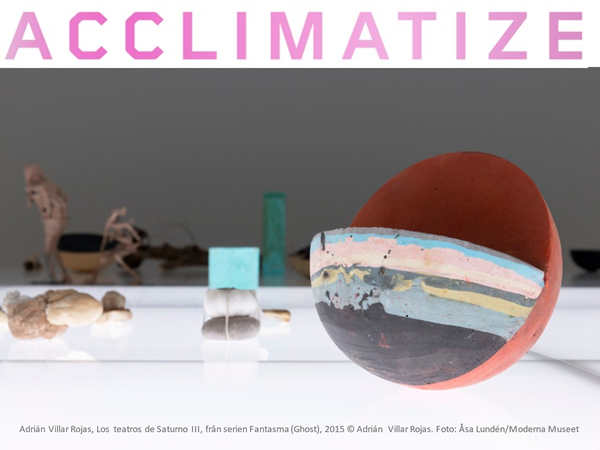ACCLIMATIZE Symposium organised by Moderna Musset and MISTRA-EC

The Acclimatize Symposium investigated the evolving role of museums in contemporary society, especially in the climate crisis. The day explored how museums, exhibitions and artists situate themselves in addressing sustainability, and what challenges and obstacles are present that hinder the world of fine art from more acutely taking action towards more sustainability, as well as, defining what tools are needed and available to overcome these issues.
Throughout the day, several curators, academics and artists spoke about how they work with sustainability and explored how this work could evolve towards more sustainability in the future. Lotten Gustafsson Reinius, a professor in ethnology at Stockholm University and Hallwylsk guest professor in ethnology at Nordiska Museet, presented how the work with the exhibition “Arktis - medan isen smälter” used the concept of “tentacular thinking”, described by Donna Haraway, to reach beyond the walls of Nordiska Museet. Using this thinking the exhibition was able to invite voices also with merits from outside the world of fine arts to develop, reflect on and speak of the ideas the exhibition addressed. Academics and adventurers who have explored and studied the Arctic were heard in the process of developing and performing the exhibition, as well as, those whose homes are in the Arctic or have heritage from there. In doing this, the exhibition was able to address sustainability issues in ways beyond the traditional.
Jonna Bornemark, a professor in philosophy at Södertörns Högskola, approached thechanging role of the museum by emphasising that the role of art is to create multiple new “us”. Enabling community building that is inclusive and ever-changing, and opening for new kinds of actions and opportunities for inspiration. By reframing who “we” are, museums and fine art have the opportunity to include communities that may often be overlooked, to bridge actors in polarization, and to reach out to the more-than-human. In societies that are becoming more efficient and rational, this ability of fine art needs to be communicated so that modern societies understand the museums hard-to-measure values.
Process lead Daniel Urey and curator Karin Englund from Färgfabriken used their time to present the project “Lyssna. - om klimat i gränslandet mellan kunskap och känslor”, a collaboration between Färgfabriken, Viserums konsthall and Skellefteå konsthall, which also included our very own Extraordinary Professor Nico Carpentier, where the exhibition context was used to engage with youth. In a series of learning and creation processes youth were invited to investigate their understanding of the climate crisis and the emotional experiences the crisis triggers. This project created opportunities for co-learning and co-creating, opportunities that are needed more extensively as the climate crisis increases and new solutions need to be developed. Especially as youth feels the climate crisis more acutely than most, these energetic actors need to be granted space in fine arts to formulate responses and process their experiences.
In breakout sessions, participants in the symposium were invited to discuss and think together about the challenges and obstacles for enabling museums to act towards more sustainability, as well as, defining what responsibilities museums have and what tools can be used to own up to these. The obstacles mentioned included the tendency of media to parenthesise the art climate actions, the disconnect between who visits museums and the museums’ ambitions to reach further, and the need for clarity in the mission of museums. Even though the climate debate is not complete without the voice of the arts, the voice itself is often not granted space in the wider society and is often not heard by those who may need it to take action. The museums themselves are also hindered in taking decisive action in sustainability efforts, such as reducing transports or transition away from the use of plastics, due to guidelines and missions from politicians and actors-in-power being diffuse or antiquated.
The breakout sessions defined that the role of museums is to create spaces to reflect, explore and raise new questions, perhaps without the responsibility of generating answers or measurable results. Hopefully, in doing so, fine art is able to inspire the wider society to see the world differently and take action as they, without these spaces and questions, otherwise would not have. To further these investigations and question building, perhaps museums should invite what is more cross-disciplinary and develop dialogues between themselves and academics, politicians and the public beyond. And in so doing, the questions museums are able to ask could be answered in contexts beyond fine art.
In finishing remarks, the symposium formulated that museums used to have the role of mirroring society and be caretakers of cultural heritage for the future, but it seems the role is evolving into museums being more agents of change and activists. To perform this new role, there is a need for more cross-disciplinary collaboration between multiple museums, and between museums, politicians, media, academia and the public. The climate crisis has brought this into stark view as a planetary issue seemingly impossible to get an overview of. Perhaps through these cross-disciplinary engagements and clearer communication in guidelines and missions, museums and fine art could enable deeper understanding of the climate crisis and inspire society as a whole to make the essential changes needed for a sustainable future.